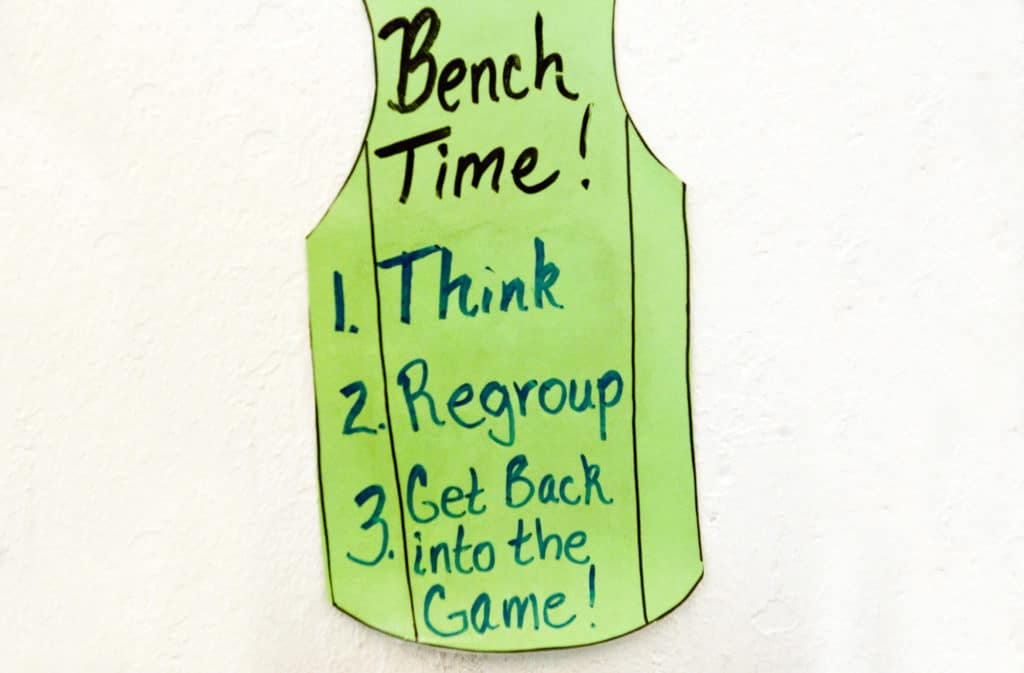
by Gina Castelli
At least once a year, one colleague or another comes to me and says, “Gina, something is not right. Can you observe my class and see if you can figure out what’s going on?” When I observe the class, I might see the teacher tell the same student three times to listen during read-aloud time. Or maybe, students keep talking during Morning Meeting even after being reminded to pay attention, and the teacher has to stop the activity to go over Morning Meeting rules. The answer becomes clear to me—and when I tell the teacher she is not using time-out consistently enough when students need a break, it becomes clear to her, too. She knows time-out is important, but as the year goes on, it becomes harder to maintain the habit of using it.
My question when I work with teachers often becomes “Who is seeing time-out as a punishment? The students—or you?”
In the beginning of the year, Responsive Classroom teachers work hard to create a safe space and a positive classroom community with rules that grow out of meaningful goals. Teaching the ins and outs of time-out (or whatever name you use for it in your classroom) early on through Interactive Modeling is an essential way to support those rules. And early in the school year, time-out may be used just as it needs to be. But as the year goes on and academics become more demanding, time-out can sometimes fall by the wayside. You may also feel more hesitant to send students to time-out as you build stronger relationships with them. But when time-out is used inconsistently and only in more extreme situations, it can feel like punishment to both students and teachers. If that’s happening, we need to remember the purpose of time-out: to give students a chance to cool down, recognize and fix their mistakes, and build internal control over their own behavior.
Take a look at your own classroom. Are you seeing students repeat the same misbehaviors even after you’ve corrected them multiple times? Try going back to basics with time-out. Reaffirm with students that the purpose of sending them to time-out is to help them get back in control of their behavior, not to punish them. If necessary, use Interactive Modeling to reteach the steps of time-out, including the options for what they can do once they’re there: deep breathing, writing in a journal, squeezing a stress ball, or other activities you approve that will help them calm down and focus. And be sure to check in with yourself, too, making sure you’re using a calm voice and avoiding negotiations when sending students to time-out.
Once you’ve reestablished the basics of time-out in your classroom, keep the practice going strong. The mantra that helps me remember to do this is “early, often, and for everyone.”
As time goes on in classrooms where time-out is used consistently, students will grow to recognize their own signals for when they need to take a break. As appropriate, you can encourage them to start going to time-out on their own when they need a moment to gather themselves—even before any misbehavior begins. This is a skill that will serve them well not only in the classroom but also in their life outside school, both now and in the future.
You might sometimes need to use reminding language before sending a student time-out. Or, you might use time-out in conjunction with loss of privilege or reparation (“you break it, you fix it”). But one thing I know is that when we as teachers do not use time-out appropriately and with purpose, it quickly turns into the punishment we do not want it to be. As Rules In School: Teaching Discipline in the Responsive Classroom reminds us, “Using time-out early helps preserve children’s relationships and the teacher’s feelings of empathy towards students.” And that can lead to a more positive classroom environment for everyone.
There’s one other important piece of the puzzle to remember: how you talk about time-out with parents. Many of them may have heard of (or used) time-out as punishment, so it’s important that they understand how this technique is used in the Responsive Classroom approach. My own kids have experienced time-out in their Responsive Classroom school, and it was hard even for me to hear when they came home in the first couple weeks of school and said, “I went to time-out two times today!” Just as you do with students, take every opportunity to emphasize to parents what time-out is for, and that it is used early, often, and for everyone.
I have read that it takes doing something 27 times to make it a habit. We as teachers have to make it a habit to use positive time-out early, often, and for everyone. When we do, we allow the students in our classrooms to use time-out in the way it is intended: as a time and place to regain self-control.
Learn more about using time-out to help students learn self-control in: